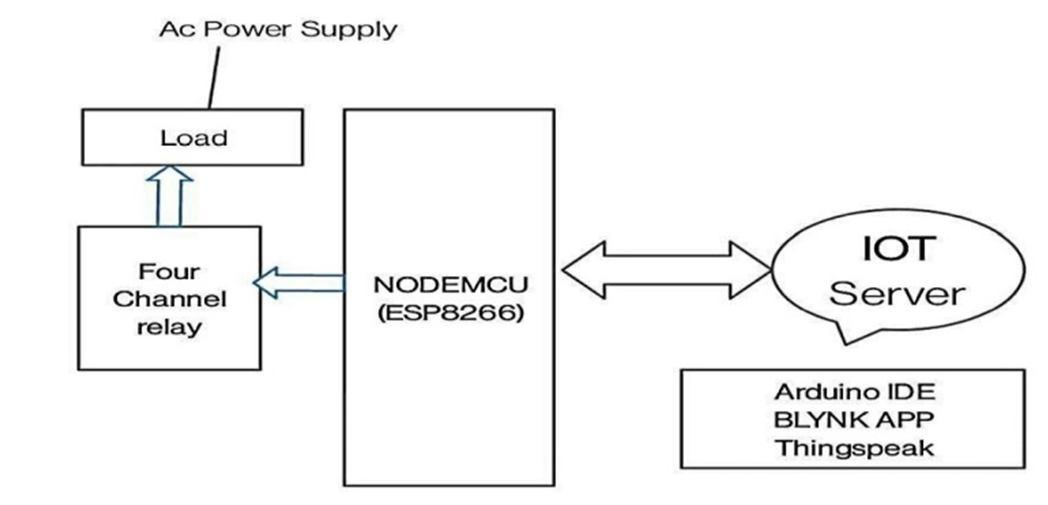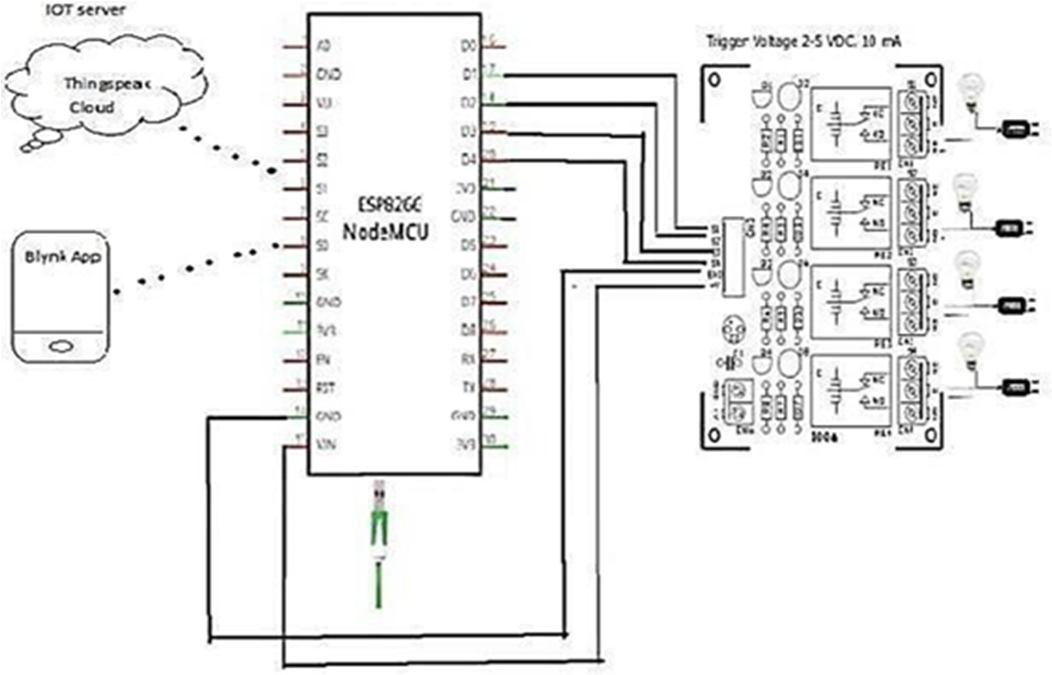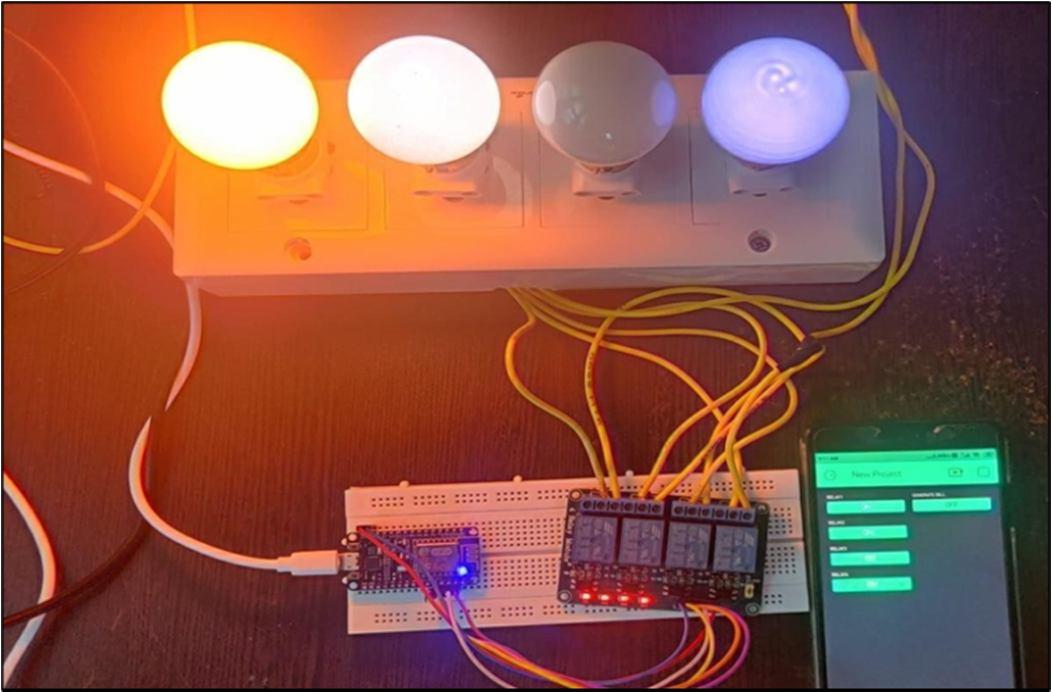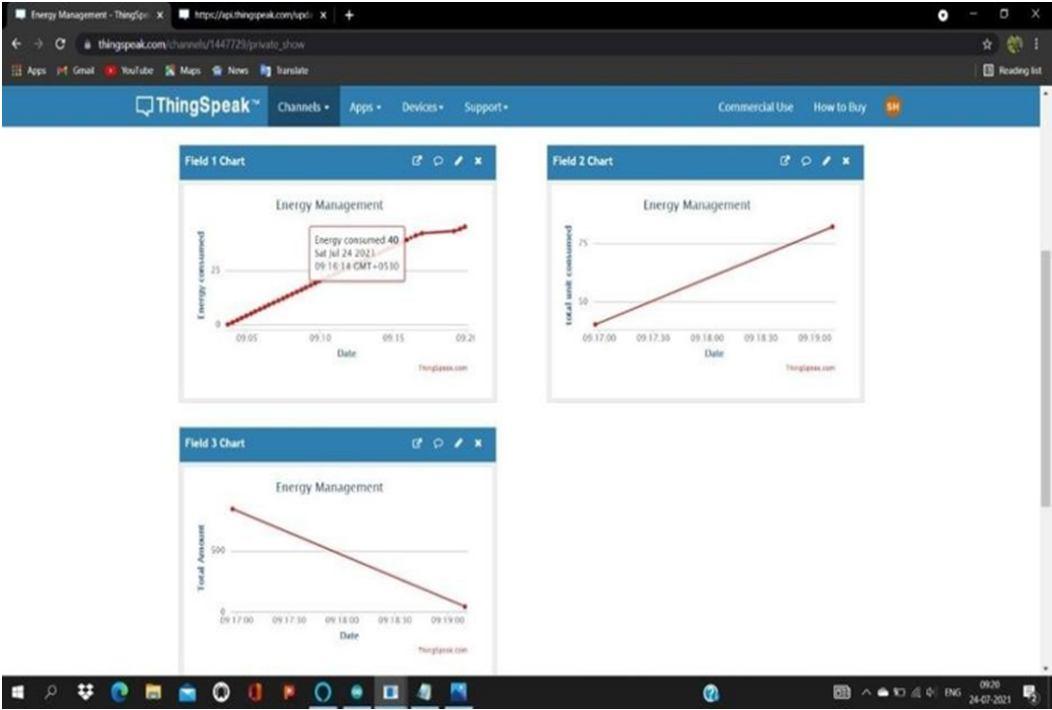

IoT Based Power Consumption
Ravikumar Reddy1 , Sangamnath Sulegaon2, Dr. Shailaja Shastri3
Department of Computer Science and Engineering. Poojya Doddappa College of Engineering. Kalaburagi, Karnataka 585102, India

Abstract: With the increasing electrical demand and new devices focused on getting the most and cheapest energy possible, the usage of energy management system is escalating both in end user and for utilities. The main objective is to minimize energy cost without affecting comfort.
This project enables the user to monitor the power consumption through webpage so that the appliances can be controlled through mobile. Data is collected as a input which is further processed using Nodemcu in order to get the magnitude of the various power consumption.
This data is later sent to the cloud-based platform Thingspeak for data analysis. It helps in plotting daily and annual load curve using data analysis technique.

By graphical analyses in Thingspeak we can control the energy wastage using blynk app. The software implementation IOT allows objects to be sensed or controlled remotely across existing network infrastructure, creating opportunities for more direct integration of the physical world into computer-based systems, this leads towards more secure, cost-effective and sustainable energy in future.
I. INTRODUCTION
Electricity has become one of the basic requirements of man. It is used in the home, industry and agriculture. With the increasing demand for energy, there is a need to use alternative energy sources in the production of electricity, but the methods of generating energy from renewable sources face many complexities and challenges. For this reason, extensive modifications and changes to existing energy systems are carried out.
Energy Management Systems (EMS) are widely used in all locations to reduce electricity costs as well as improve energy efficiency. Rising economic growth and consumption patterns lead to an ever increasing demand for energy. As the majority of energy supply comes from fossil fuels, the resource is being depleted, increasing energy costs.
Burning fossil fuels has also increased the concentration of carbon dioxide in the environment, leading to extreme weather fluctuations. It is therefore imperative that industries and commercial enterprises take steps to reduce energy waste, become energy efficient and reduce costs. Energy Management Systems (EMS) are widely used in all locations to reduce electricity costs as well as improve energy efficiency.
EMS itself finds its better opportunity on the demand side in the management and mass consumption of energy. The introduction of EMS allows for the central integration of data with utilities and the ability to predict the possibility of communicating real time energy market tariffs to end users, which allows to sell or buy energy at the most convenient moments. The increasing integration of renewable energy sources and electric assets will push the requirement to have a global and centralized EMS and new devices aimed at obtaining the most and cheapest energy, the use and release of energy management systems (EMS) is escalating both for end users. and for utility networks. An energy management system (EMS) is a set of computer tools used to monitor, control and optimize the performance of generation and transmission systems. the energy management software control system is designed to reduce energy consumption, improve system utilization, increase reliability and predict electrical system performance, as well as optimize energy consumption to reduce costs. EMS itself finds its better opportunity on the demand side in the management and mass consumption of energy. Recent EMS improvements have been made to address the challenges of energy sustainability and reliability. Electricity costs form the main budget of an educational institution. It would be much better to reduce your electricity bill with EMS. The proposed model uses a centralized energy management system that allows monitoring energy consumption and performance in different time periods. EMS refers to a computer system designed specifically for the automated control and monitoring of electromechanical equipment in buildings that provide significant energy consumption, such as heating, ventilation and lighting. The scope can range from a single building to a group of buildings such as universities, office buildings, retail chains or factories. The data obtained can be used to perform self diagnosis and optimization routines and to create trend analysis and annual consumption forecasts. Most of these energy management systems also provide decision making.
Science
Engineering Technology (IJRASET

ISSN: 2321 9653; IC Value: 45.98; SJ Impact Factor: 7.538 Volume 10 Issue IX Sep 2022 Available at www.ijraset.com
II. LITERATURESURVEY
1) Mehdi Larakia, Oussa Mohamed, Aawatif Haya Design and implementation of a new intelligent energy management system for modest smart cities ― Smart implementation in 2018 refers to a house in which a series of connected devices and home appliances perform certain actions to monitor energy, optimize its use and thereby save money. A smart house also represents a house that meets its needs in an intelligent and flexible way, reacts to the needs and comfort of its inhabitants and allows them to control and manage the consumption of their own green energy sources. The objective of this paper is to present the design and implementation of a cost effective energy management system suitable for modest smart cities and smart villages.
2) Reis, R.F.M. Brandao energy management systems. Here, the authors describe the use and importance of energy management systems (EMS), applied both to energy companies and to end customers as a means of monitoring electricity consumption and achieving energy savings. This approach also benchmarks existing systems and devices along with the growing use of EMS in the latest smart grids.
3) Mayur D, Karathia Jignesh G, Bhatt Himanshu G, Bhavsar Intelligent Energy Management System. The project carried out PG dissertation level work and presents a detailed design and implementation of an industrial EMS. MODBUS compliant sensors and modules are connected to a field level RS 485 network that is connected to a PC based master control system. The proposed system monitors and records energy consumption data online and helps to increase the energy efficiency of the system. Offline diagnostics in the database helps to plan preventive actions to save electricity and further optimize the overall system. Remote access is also used via intranet/internet. Various functions of the proposed system were verified by laboratory implementation.
4) "Garrab, A.; Bouallegue, A.; Ben Abdallah" "A New AMR Approach to Energy Savings in Smart Grids Using Smart Meter and Partial Power Line Communication", 2012. In this the authors described e.g. the increasing demand for energy Capacity constraints energy management, one way communication, the need for interoperability of different standards, communication security and greenhouse gas emissions lead to the emergence of a new infrastructure network: Smart Grid. Smart Meters are one of the proposed solutions for Smart Grid. This document presents an AMR solution that provides enhanced end to end applications. It is based on the MSP430FE423A low power microcontroller power meter and Power Line Communication standards. The microcontroller includes an ESP430CEl energy measurement module. The aim of this work is to realize pricing in real time thanks to the designed communication infrastructure. This solution is of great interest from the economic and low carbon point of view of society.
5) "B. S. Koay, S. S. Cheah, Y. H. Sng, P. H. Chong, Y. X. Zuo, and H. W. Kuek", "Bluetooth Energy Meter Design and Implementation", 2018. Electronic energy metering is currently steadily replacing existing electromechanical meter technology, especially in China and India. By 2004, digital meters had begun to replace electromechanical meters in Singapore. A wireless digital energy meter would definitely offer more convenience in meter reading. Bluetooth technology is chosen as a possible wireless solution to this problem. In this paper, we present the design and implementation issues of a Bluetooth enabled electricity meter. The energy reader can collect energy consumption data from the electricity meter wirelessly based on Bluetooth
6) Landi, C.; Dipt. Di Ing. Dell ‘’Inf., Seconda Univ. di Napoli, Aversa, Italy; Merola, an ARM based control system using a smart meter and web server, 2019. A low cost real time ARM based energy management system is proposed. It is designed as part of a distributed system that measures the main quantities of the energy system and gives the possibility to control the entire power plant. An integrated web server enables the collection of statistical data on power consumption, power quality and is able to connect load shifting devices. The device features easy access to information, and the combination of a smart meter and data communication capability allows both local and remote access. In this way, it is impossible to control the energy consumption of the energy system, which leads to an overall reduction in consumption and costs.
III. METHODS

A. Create a channel and collect data
The core element of ThingSpeak is the ThingSpeak channel. The channel stores the data we send to ThingSpeak and consists of the elements below: 8 data storage fields of any type Can be used to store data from a sensor or an embedded device. 3 location fields
Can be used to store latitude, longitude and altitude. These are very useful for tracking a moving device. 1 status field A short message describing the data stored in the channel. In order to use ThingSpeak, we need to register and create a channel. Once we have a channel, we can send the data, let ThingSpeak process it, and retrieve it as well.
Create a ThingSpeak account
(IJRASET
ISSN: 2321 9653; IC Value: 45.98; SJ Impact Factor: 7.538

Volume 10 Issue IX Sep 2022 Available at www.ijraset.com
Open https://thingspeak.com/ and click the Start Now button in the middle of the page and you will be redirected to the registration page. Fill in the required information and click the Create Account button.
We should now see a page (w.r.t Figure 5.2.4) confirming that the account has been created successfully. The confirmation message will disappear after a few seconds and the last page will be created. • After logging in, you must create a new channel to save data. To do this, go to Channels >My Channels and click New Channel
Enter channel name and field name 1 in the corresponding sections. fields in a channel are used to store data and each channel can have up to 8 fields. after entering the detail we will save the channel Scroll down, check the box show status and click save. So after clicking save button, a new page will open as shown below.
As the channel name at the top of Nodemcu's ThingSpeak. All selected fields are automatically added as shown in Figure 5.2.8. To copy API keys, click API keys, you can always generate new keys. Now we only use channel ID and Write API key because we will only send data from Nodemcu ESP8266 to ThingSpeak IoT Platform
B. Data Analysis and Visualization
ThingSpeak enables sensors, devices and websites to send data to the cloud, where it is stored in a private or public channel
ThingSpeak stores data in private channels by default, but public channels can be used to share data with others. Once the data is in the ThingSpeak channel, it can be analyzed and visualized, calculate new data, or interact with social media, web services, and other devices.
The private view displays a chart corresponding to each of the fields we added. Now click on the Public View tab. It should look exactly like what we see in the Private View tab since our channel is public. In case your channel is not public (the "publish" checkbox is not checked in the channel settings tab), the public view tab will show a message that "This channel is not public.
Cloud storage provides easy access. We can explore and visualize data using online analytics tools. We can discover patterns, trends in data and can visualize them in charts, graphs and gauges.
C. Blynk App

Blynk was designed for the Internet of Things. It can control hardware remotely, can display sensor data, can store data and visualize. The platform has three main components: Blynk App allows you to create an interface for projects using the various widgets we provide. Blynk Server responsible for all communication between smartphone and hardware. Blynk Cloud can run a private Blynk server locally. It's open source, easily handles thousands of devices. Blynk libraries for all popular hardware platforms enable communication with the server and handle all incoming and outgoing commands. Every time we press a button in the Blynk app, a message moves to the Blynk Cloud space, where it finds its way to your hardware.
IV. SOFTWAREARCHITECTURE
The figure 1 is the interface of hardware and software. The hardware consists of NodeMCU, four channel relay, and the software consist of Arduino IDE software, Blink app, Think speak. Each relay is connected to load and also to the NodeMCU. NodeMCU is embedded with Wi Fi module which has wireless connectivity to thinkspeak and Blink app. Through blink app we can turn on/off and even generate a bill of energy consumption
Consumption System

ISSN: 2321 9653; IC Value: 45.98; SJ Impact Factor: 7.538 Volume 10 Issue IX Sep 2022 Available at www.ijraset.com

The project requires NodeMCU, 4 channel relay, BlynkApp, Thingspeak, Arduino software 1.8.15. The connections are made as shown in Figure 17. Each channel relay is connected to the respective loads. The relay inputs IN1,IN2,IN3,IN4 are connected to D1,D2,D3,D4, the ground of the relay is connected to the ground of the NodeMCU. The Vcc relay is connected to the Vin of the NodeMCU. The program is coded on nodemcu's Arduino platform, which is then uploaded. Data mining is in the form of a loop function at an interval of 10 seconds. This data is sent to the ThingSpeak cloud server via Nodemcu, which has a built in WiFi module for communication purposes. This data is further analyzed as graphs on this website providing details regarding data time and amount of power consumption. Here we consider 1 unit = 60 watts. Three graphs appear in Thinkspeak. In which the first graph shows the current power consumption. It shows the time required to consume one unit of energy. When all loads are on, unit consumption is fast, and when the load is reduced, the time required for unit consumption is shorter. The second graph shows the total energy consumption and the third graph shows the total amount of energy consumed. We can monitor and analyze energy consumption through a graphical display. The four channel relay is controlled by BlynkApp by switching the load on/off. In this way, unwanted energy consumption can be minimized. Through BlynkApp, we can generate a bill of total load consumption for a specific period. We consider 20 rupees per unit for account generation. Here we consider two models. In the first one, when all loads are on, we check the maximum unit consumed. In the second model, we take as the unit consumed as a reference and compared with the other. When the consumed unit is bigger than the first or if it is half/full of the one we consumed, a warning massage will be given. By controlling it with the blink app, we manage energy.

VI. RESULT
The figure shows the proposed prototype with node connection. The power source supply is connected to Node MCU and when the relay is turned on the LED light glows and this operation is carried out through blynk app.


ISSN: 2321 9653; IC Value: 45.98; SJ Impact Factor: 7.538

10 Issue IX Sep 2022 Available at www.ijraset.com
Graphical view of model

The graph shows model 1 load consumption when all loads are on. A time period of 30 min is considered here. Chart1 shows 80 units as the maximum consumed load. For the second model, when the consumed unit is half/full of the first model, we get a warning massage. This means checking for waste and taking further action.
By following the graph, if the unit consumption is high, we can reduce the power consumption by turning on/off the load. Overall, the system is able to manage energy through monitoring, analysis and control. Therefore, costs are reduced. Using this model, we can monitor and optimize energy consumption to save energy consumption. This leads to a safer, more cost effective and sustainable energy future
VII.CONCLUSION
The project is implemented in hardware and software components that interact through network connections. The main task is to implement the project in an economical way so that it can be easily deployed. An efficient energy management system can save energy (kWh) and help ensure better optimization.
A software implementation of the IoT allows objects to be sensed or controlled remotely within the existing network infrastructure, creating opportunities for more direct integration of the physical world into computer systems, resulting in greater accuracy and economic benefit. A smart energy system is a cost effective and sustainable energy based system in which renewable energy production and consumption infrastructures are integrated, interconnected and coordinated through energy mobile applications, active users and supporting technologies
REFERENCES
[1] Z. Yu, B. C. M. Fung, F. Haghighat, H. Yoshino, and E. Morofsky, ―A systematic procedure to study the influence of occupant behavior on building energy consumption,‖ Energy and Buildings, vol. 43, no. 6, pp. 1409 1417, 2011. [Online]. Available: http://dx.doi.org/10.1016/j.enbuild.2011.02.002
[2] S. Chen, N. Li, and J. Guan, ―Research on statistical methodology to investigate energy consumption in public buildings sector in China, Energy Conversion and Management, vol. 49, no. 8, pp. 2152 2159, 2008.
[3] H. Doukas, K. D. Patlitzianas, K. Iatropoulos, and J. Psarras, ―Intelligent building energy management system using rule sets,‖ Building and Environment, vol. 42, no. 10, pp. 3562 3569, 2011.Parallax, ―XBee USB Adapter Board (# 32400 ),‖ XBee USB Adapter datasheet, 2013.

[4] F. Akyildiz, W. Su, Y. Sankar Subramaniam, and E. Cayirci, ―Wireless sensor networks: a survey, ‖ Computer networks, vol. 38, no. 4, pp. 393 422, 2014.
[5] J. Yick, B. Mukherjee,

